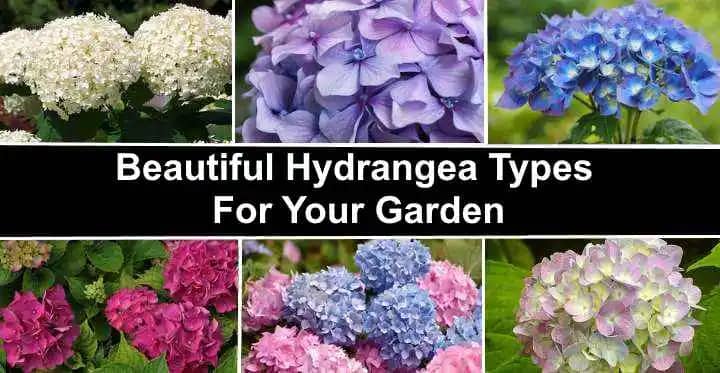Overview of Hydrangeas
Hydrangeas are beautiful flowering plants that brighten up gardens with their large, colorful blooms. Known for their lush, round flower clusters, hydrangeas come in a variety of colors, including blue, pink, white, and purple. These versatile plants can be grown in many different climates and are a favorite among gardeners worldwide.
History and Origin of Hydrangeas
Hydrangeas have a rich history, originating in Asia and the Americas. They were first discovered in Japan and were later introduced to Europe in the 18th century. Today, hydrangeas are popular ornamental plants found in gardens all around the world.
Types of Hydrangeas
1.Bigleaf Hydrangea (Hydrangea macrophylla)
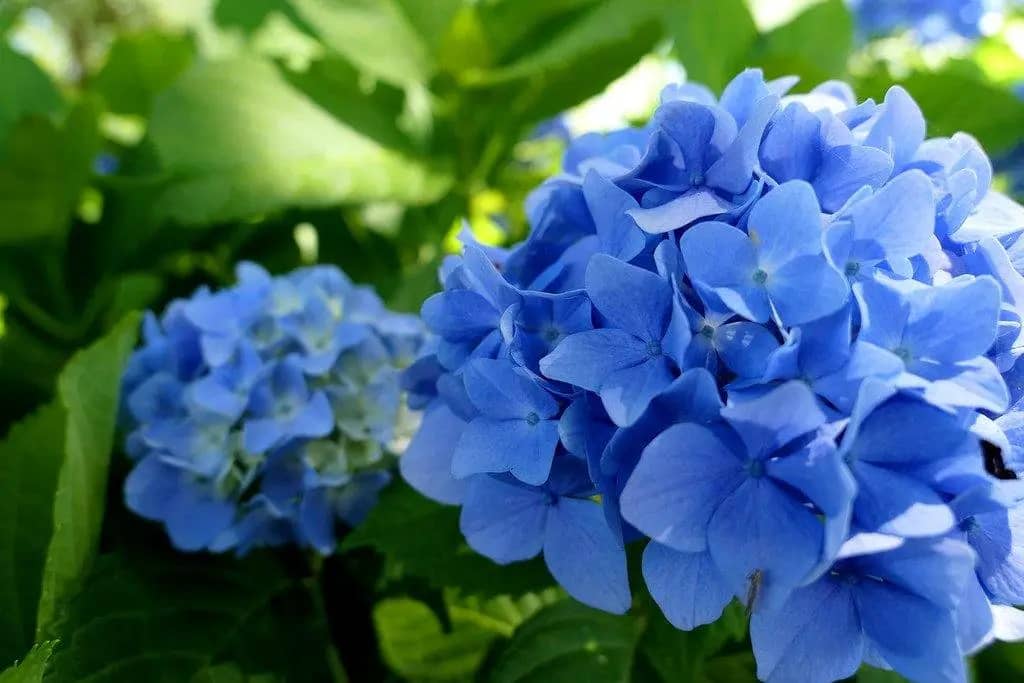
he Bigleaf Hydrangea, scientifically known as Hydrangea macrophylla, is a popular ornamental shrub known for its large, vibrant blooms and lush foliage. Native to Japan and Korea, this deciduous plant is cherished in gardens and landscapes worldwide for its ability to produce stunning flowers that change color based on soil pH.
Basic Informtaion Of Hydrangea macrophylla
- Plant Type: Deciduous shrub
- Family: Hydrangeaceae
- Height: Typically 3 to 6 feet tall
- Spread: 3 to 6 feet wide
- Bloom Time: Summer
- Flower Color: Pink, blue, or purple depending on soil pH
- Foliage: Large, dark green, serrated leaves
Growing Conditions Of Hydrangea macrophylla
- Light Requirements: Partial shade to full sun. In hotter climates, partial shade is preferred to prevent leaf scorch.
- Soil Requirements: Prefers moist, well-drained soil rich in organic matter. The soil pH affects flower color: acidic soils (pH < 6) produce blue flowers, while alkaline soils (pH > 6) produce pink flowers.
- Watering Needs: Regular watering, especially in dry periods. Mulching can help retain soil moisture.
- Hardiness Zones: USDA zones 5 to 9.
Care and Maintenance Of Hydrangea macrophylla
- Pruning: Prune immediately after flowering to shape the plant and remove dead or weak stems. Avoid heavy pruning as it can reduce next year’s blooms.
- Fertilization: Apply a balanced, slow-release fertilizer in spring and summer. Adjust fertilizer type to influence flower color if desired.
- Pest and Disease Control: Generally resistant to pests, but watch for aphids, spider mites, and powdery mildew. Proper spacing and air circulation can prevent most fungal diseases.
Uses in Landscaping
Bigleaf Hydrangeas are versatile plants used in a variety of garden settings. They make excellent border shrubs, foundation plants, or focal points in mixed beds. Their showy blooms are also popular in cut flower arrangements.
Interesting Facts Of Hydrangea macrophylla
- The color of Bigleaf Hydrangea flowers can be changed by altering the soil pH: aluminum sulfate can be added to soil to turn flowers blue, while garden lime can make them pink.
- Hydrangea macrophylla is divided into two main types: mophead (large, rounded flower clusters) and lacecap (flat flower clusters with a central disk of small flowers surrounded by larger, showier flowers).
For Complete Detail About Hydrangea macrophylla Click Here Hydrangea Macrophylla Your Ultimate Guide
2.Smooth Hydrangea (Hydrangea arborescens)
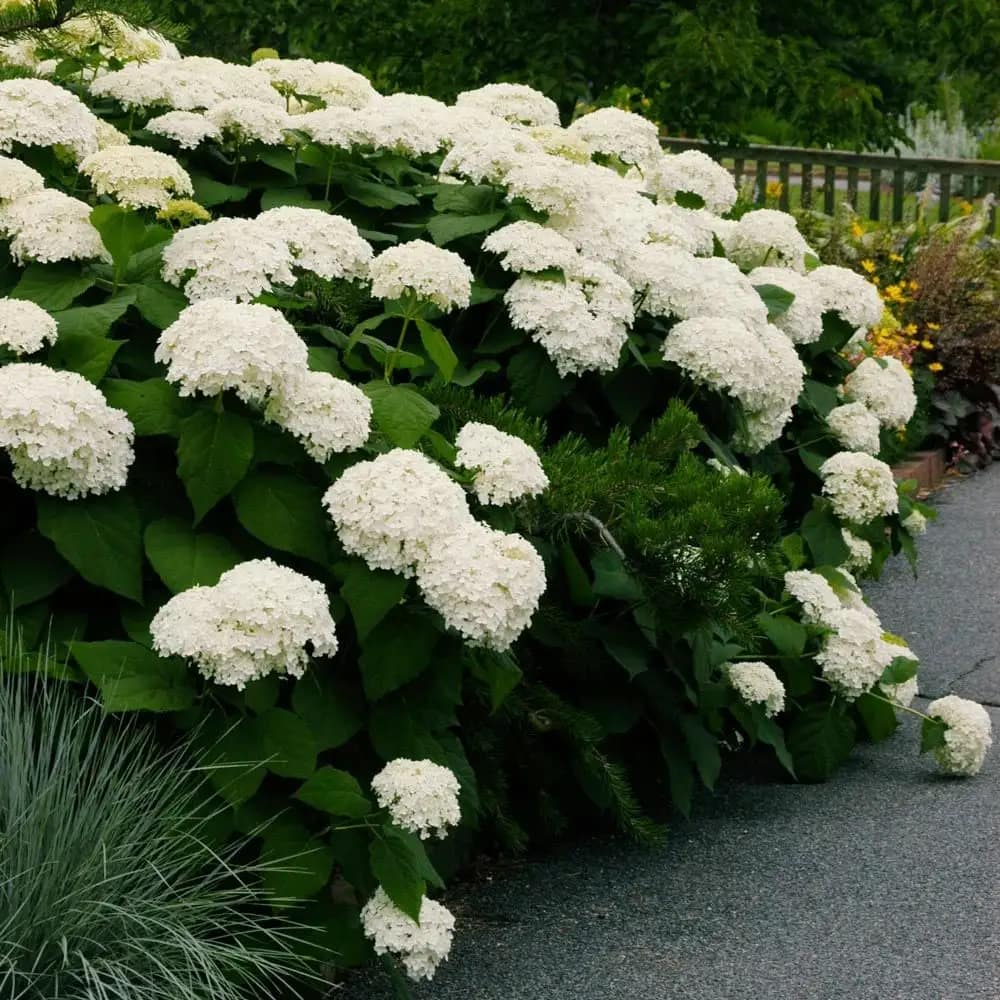
The Smooth Hydrangea, scientifically known as Hydrangea arborescens, is a resilient and low-maintenance shrub renowned for its large, spherical flower clusters and adaptability to various garden conditions. Native to the eastern United States, this deciduous shrub is a favorite among gardeners for its ease of care and reliable blooming.
Description of Smooth Hydrangea
- Plant Type: Deciduous shrub
- Family: Hydrangeaceae
- Height: Typically 3 to 5 feet tall
- Spread: 3 to 5 feet wide
- Bloom Time: Late spring to early fall
- Flower Color: White or pale green, turning to a light pink or tan as they age
- Foliage: Oval, dark green leaves
Growing Conditions of Smooth Hydrangea
- Light Requirements: Full sun to partial shade. In hotter climates, partial shade is preferred to prevent leaf scorch.
- Soil Requirements: Prefers moist, well-drained soil rich in organic matter. Tolerates a range of soil pH levels but thrives in slightly acidic to neutral soil.
- Watering Needs: Regular watering, especially during dry spells. Mulching helps to retain soil moisture and keep roots cool.
- Hardiness Zones: USDA zones 3 to 9.
Care and Maintenance of Smooth Hydrangea
- Pruning: Prune in late winter or early spring before new growth begins. Smooth Hydrangeas bloom on new wood, so annual pruning encourages robust flowering and helps maintain a desirable shape.
- Fertilization: Apply a balanced, slow-release fertilizer in early spring. Avoid over-fertilizing, which can lead to lush foliage at the expense of blooms.
- Pest and Disease Control: Generally resistant to pests and diseases, but keep an eye out for aphids, spider mites, and leaf spots. Ensuring good air circulation and avoiding overhead watering can prevent most fungal issues.
Uses in Landscaping of Smooth Hydrangea
Smooth Hydrangeas are versatile and can be used in various garden settings. They are ideal for mass plantings, borders, foundation plantings, and as focal points in mixed beds. Their large, showy blooms are also excellent for fresh and dried floral arrangements.
Interesting Facts of Smooth Hydrangea
- One of the most popular cultivars of Hydrangea arborescens is ‘Annabelle,’ known for its massive, globe-shaped flower clusters that can reach up to 12 inches in diameter.
- Smooth Hydrangeas are more cold-hardy than other Hydrangea species, making them suitable for gardens in northern climates.
Popular Cultivars of Smooth Hydrangea
- ‘Annabelle’: Known for its large, white flower heads.
- ‘Incrediball’: Features extremely large, sturdy white blooms.
- ‘Invincibelle Spirit’: The first pink-flowered form of Smooth Hydrangea, with strong stems and continuous blooming.
More information about Smooth Hydrangea Click Here Smooth Hydrangea The Ultimate Care, Tips And More
3.Panicle Hydrangea (Hydrangea paniculata)
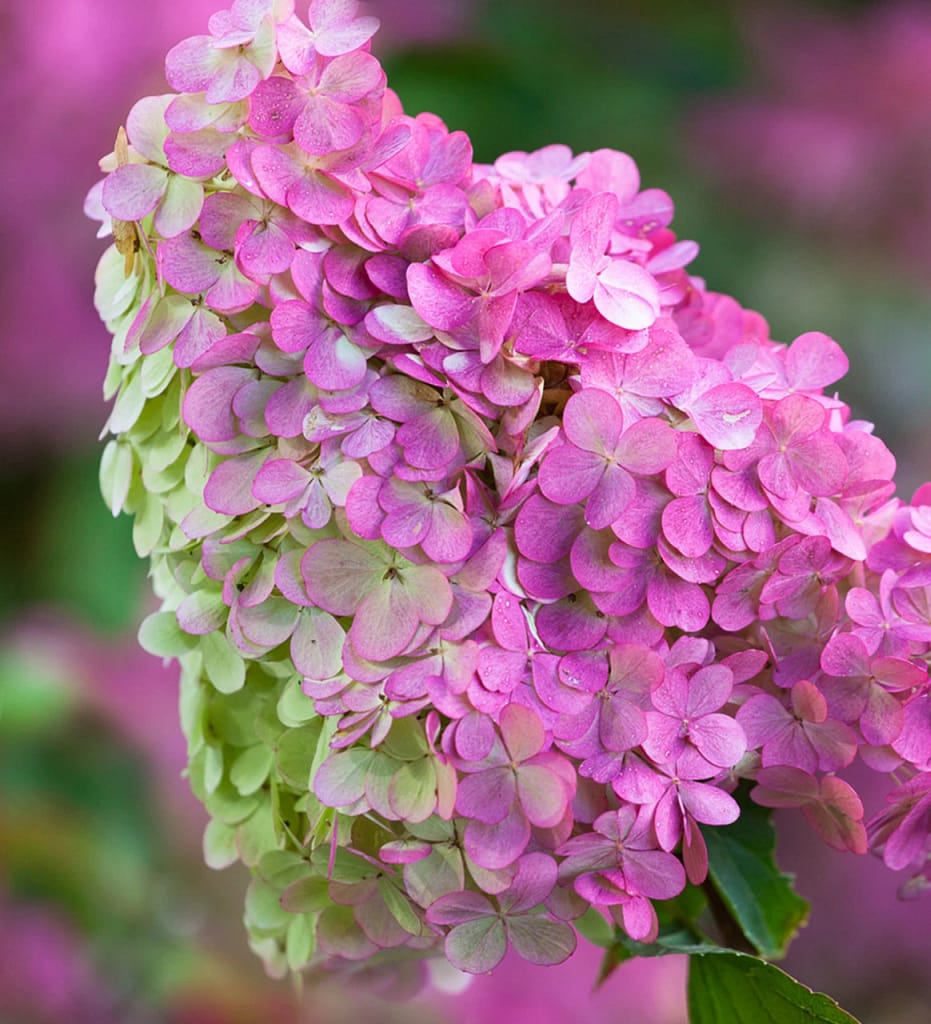
Panicle hydrangeas have cone-shaped flower clusters and can grow quite large. They are known for their ability to change color as the flowers age, often starting white and turning pink or even red.
if You want to Know About This Pink Hydrangea click here Pink Hydrangea for Every Garden: Trees, Bushes, and Climbing Varieties
3.Oakleaf Hydrangea (Hydrangea quercifolia)
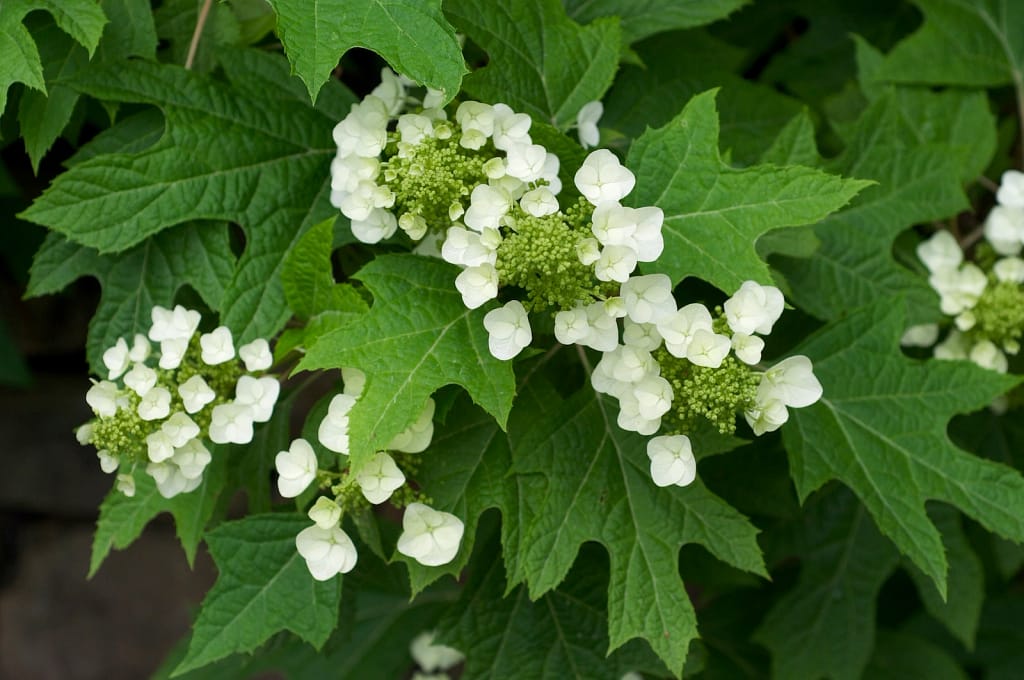
The Oakleaf Hydrangea, scientifically known as Hydrangea quercifolia, is a distinctive and versatile shrub appreciated for its beautiful, lobed leaves that resemble oak leaves, and its attractive, cone-shaped flower clusters. Native to the southeastern United States, this deciduous shrub offers year-round interest with its changing foliage colors and striking bark texture.
Description of Oakleaf Hydrangea
- Plant Type: Deciduous shrub
- Family: Hydrangeaceae
- Height: Typically 4 to 8 feet tall
- Spread: 4 to 8 feet wide
- Bloom Time: Late spring to early summer
- Flower Color: White, turning to pink or purplish with age
- Foliage: Large, deeply lobed, oak-like leaves; vibrant green in spring and summer, turning red, orange, and purple in the fall
Growing Conditions of Oakleaf Hydrangea
- Light Requirements: Partial shade to full sun. In hotter climates, partial shade is preferred to prevent leaf scorch.
- Soil Requirements: Prefers moist, well-drained soil rich in organic matter. Tolerates a range of soil pH levels, but performs best in slightly acidic to neutral soil.
- Watering Needs: Regular watering, especially during dry spells. Mulching helps retain soil moisture and keeps roots cool.
- Hardiness Zones: USDA zones 5 to 9.
Care and Maintenance of Oakleaf Hydrangea
- Pruning: Prune after flowering to shape the plant and remove dead or damaged wood. Oakleaf Hydrangeas bloom on old wood, so avoid heavy pruning which can reduce next year’s blooms.
- Fertilization: Apply a balanced, slow-release fertilizer in early spring. Over-fertilizing can lead to lush foliage at the expense of blooms.
- Pest and Disease Control: Generally resistant to pests and diseases, but watch for aphids, spider mites, and powdery mildew. Proper spacing and air circulation can prevent most fungal issues.
Uses in Landscaping of Oakleaf Hydrangea
Oakleaf Hydrangeas are versatile plants used in various garden settings. They are ideal for woodland gardens, mixed borders, foundation plantings, and as specimen plants. Their unique foliage and changing colors provide multi-season interest, and their dried flower heads add winter beauty.
Interesting Facts of Oakleaf Hydrangea
- The Oakleaf Hydrangea’s peeling bark adds winter interest, revealing a cinnamon-brown layer beneath, which contrasts beautifully with snow.
- Unlike other Hydrangea species, Oakleaf Hydrangeas are known for their exceptional fall foliage colors, ranging from deep red to purple.
Popular Cultivars
- ‘Alice’: Known for its large, conical flower clusters and impressive size.
- ‘Snow Queen’: Features large, upright white flower panicles that turn pinkish as they age.
- ‘Pee Wee’: A dwarf variety ideal for smaller gardens, with smaller but still striking blooms and foliage.
- ‘Snowflake’: Double-flowered variety with large, cascading blooms that turn pinkish with age.
For Full Information About This Plant Click Here Oakleaf Hydrangea (Hydrangea quercifolia)
4.Climbing Hydrangea (Hydrangea petiolaris)
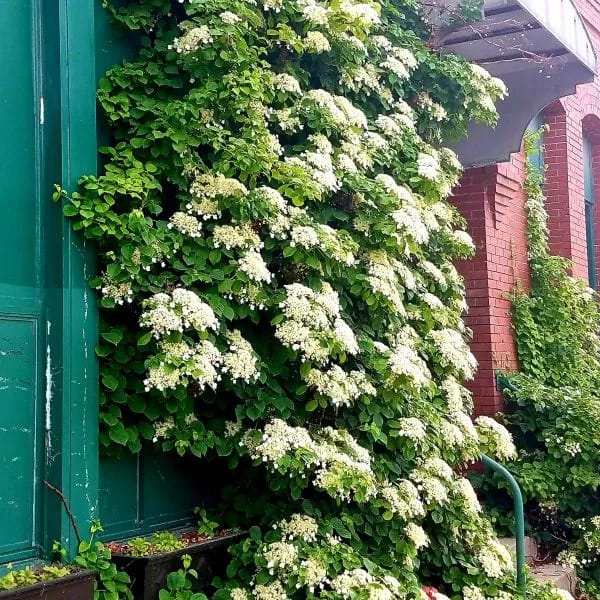
The Climbing Hydrangea, scientifically known as Hydrangea anomala subsp. petiolaris, is a vigorous, woody vine that is prized for its ability to climb walls, trellises, and trees, creating a lush, green tapestry adorned with lacy, white flower clusters. Native to the woodlands of Japan, Korea, and Siberia, this deciduous vine adds vertical interest to gardens and landscapes.
Description of Climbing Hydrangea
- Plant Type: Deciduous vine
- Family: Hydrangeaceae
- Height: Typically 30 to 50 feet when mature, depending on support
- Spread: 5 to 6 feet wide
- Bloom Time: Late spring to early summer
- Flower Color: White, with fragrant, flat-topped clusters
- Foliage: Heart-shaped, dark green leaves; turn yellow in fall
Growing Conditions of Climbing Hydrangea
- Light Requirements: Partial shade to full sun. Prefers some shade in hotter climates to prevent leaf scorch.
- Soil Requirements: Prefers moist, well-drained soil rich in organic matter. Tolerates a range of soil pH levels.
- Watering Needs: Regular watering, especially during dry spells. Mulching helps to retain soil moisture.
- Hardiness Zones: USDA zones 4 to 8.
Care and Maintenance of Climbing Hydrangea
- Pruning: Minimal pruning required. Prune after flowering to control size and shape. Remove dead or weak branches to encourage healthy growth.
- Fertilization: Apply a balanced, slow-release fertilizer in early spring. Avoid over-fertilizing as this can lead to excessive leaf growth at the expense of flowers.
- Pest and Disease Control: Generally resistant to pests and diseases, but watch for aphids, spider mites, and powdery mildew. Ensure good air circulation to prevent fungal issues.
Uses in Landscaping of Climbing Hydrangea
Climbing Hydrangeas are ideal for adding vertical interest to gardens. They are perfect for covering walls, fences, large trellises, arbors, and even tree trunks. Their aerial rootlets allow them to cling to surfaces, creating a dense, green cover. The lacy, white flower clusters and exfoliating bark add aesthetic appeal throughout the year.
Interesting Facts of Climbing Hydrangea
- Climbing Hydrangeas are slow to establish but become vigorous climbers once rooted, often taking a few years before they start to bloom.
- The peeling, cinnamon-colored bark provides winter interest, adding to the plant’s year-round appeal.
- The flowers are fragrant and attract pollinators like bees and butterflies.
Popular Cultivars of Climbing Hydrangea
- ‘Miranda’: Variegated variety with green leaves edged in creamy white, providing additional visual interest.
- ‘Cordifolia’: A dwarf variety that is suitable for smaller spaces and container gardening.
How to Grow Hydrangeas

Hydrangeas are beloved for their beautiful, large blooms and relatively easy maintenance. Whether you’re a seasoned gardener or a beginner, following these steps will help you successfully grow hydrangeas in your garden.
1. Choosing the Right Hydrangea
Hydrangeas come in several types, each with different growing requirements:
- Bigleaf Hydrangea (Hydrangea macrophylla): Known for its color-changing blooms based on soil pH.
- Smooth Hydrangea (Hydrangea arborescens): Hardy and reliable with large white flowers.
- Oakleaf Hydrangea (Hydrangea quercifolia): Notable for its foliage that turns vibrant colors in fall.
- Climbing Hydrangea (Hydrangea anomala subsp. petiolaris): A vigorous vine perfect for vertical spaces.
Choose the variety that best suits your climate, garden space, and aesthetic preferences.
2. Planting Location
Hydrangeas generally prefer:
- Light: Partial shade. In cooler climates, they can tolerate more sun, but in hotter climates, they need protection from the afternoon sun.
- Soil: Well-drained, rich in organic matter. Hydrangeas thrive in slightly acidic to neutral soil (pH 5.5 to 7.0).
3. Planting Steps
- Timing: Plant hydrangeas in spring or fall when temperatures are mild.
- Preparation: Dig a hole twice as wide and as deep as the root ball.
- Soil Amendment: Mix the extracted soil with compost or aged manure.
- Planting: Place the hydrangea in the hole, ensuring the top of the root ball is level with the soil surface. Fill the hole with the amended soil and press down firmly.
- Watering: Water thoroughly to settle the soil and eliminate air pockets.
4. Watering
- Hydrangeas need consistent moisture, especially during their first year. Water deeply once or twice a week.
- Use mulch to retain moisture and regulate soil temperature. Apply a 2-3 inch layer of organic mulch like wood chips or bark around the base of the plant.
5. Fertilization
- Spring: Apply a balanced, slow-release fertilizer (10-10-10) to promote healthy growth.
- Summer: Avoid high nitrogen fertilizers, which can lead to lush foliage but fewer blooms.
- Adjust pH for Color (Bigleaf Hydrangeas): Use aluminum sulfate for blue flowers and garden lime for pink flowers.
6. Pruning
- Bigleaf Hydrangea: Prune immediately after flowering to avoid cutting off next year’s flower buds.
- Smooth Hydrangea: Prune in late winter or early spring as they bloom on new wood.
- Oakleaf Hydrangea: Prune after flowering, focusing on shaping and removing dead wood.
- Climbing Hydrangea: Minimal pruning; trim after flowering to maintain size and shape.
7. Pest and Disease Management
- Hydrangeas are generally resistant to pests but can occasionally suffer from aphids, spider mites, and scale. Treat with insecticidal soap or neem oil if necessary.
- Fungal diseases like powdery mildew and leaf spot can be prevented by ensuring good air circulation and avoiding overhead watering.
8. Winter Protection
- In colder climates, protect hydrangeas by mulching heavily around the base and covering them with burlap or a frost cloth during extreme cold.
9. Propagation
- Hydrangeas can be propagated through cuttings or layering. Take cuttings in late spring or early summer and root them in a moist growing medium.
Pruning Hydrangeas
Why Prune Hydrangeas?
Pruning helps maintain the shape of the plant, encourages new growth, and can improve flowering. It’s important to know when and how to prune different types of hydrangeas to avoid cutting off next year’s blooms.
When to Prune Different Types of Hydrangeas
The timing of pruning depends on the type of hydrangea. Bigleaf and oakleaf hydrangeas should be pruned after they bloom in summer, while smooth and panicle hydrangeas can be pruned in late winter or early spring.
How to Prune Hydrangeas
Use clean, sharp tools to remove dead or damaged wood first. For most hydrangeas, cut back old stems to encourage new growth. Be careful not to remove too much, as this can reduce flowering.
Propagating Hydrangeas
Methods of Propagation
Hydrangeas can be propagated through cuttings, layering, or division. Each method has its advantages and can be successful with the right technique.
Step-by-Step Guide to Propagation
For cuttings, take a healthy stem with several leaves, remove the lower leaves, and place it in water or soil to root. Layering involves bending a low branch to the ground and covering it with soil until it roots.
Tips for Successful Propagation
Keep the soil or water consistently moist and provide indirect sunlight. Patience is key, as it can take several weeks for new roots to develop.
Hydrangea Colors
Understanding Hydrangea Colors
The color of hydrangea flowers can vary based on the pH of the soil. Acidic soil (pH below 7) typically produces blue flowers, while alkaline soil (pH above 7) results in pink or red flowers.
How to Change Hydrangea Colors
To change flower color, adjust the soil pH. Adding aluminum sulfate can make the soil more acidic, turning flowers blue. Adding lime can make the soil more alkaline, turning flowers pink.
Maintaining Vibrant Colors
Regularly test the soil pH and adjust as needed. Consistent care, including proper watering and fertilization, helps maintain bright, healthy blooms.
Hydrangea and Temperature
Ideal Temperature Range
Hydrangeas generally prefer mild climates. They thrive in temperatures between 60°F and 70°F (15°C to 21°C). Extreme heat or cold can stress the plants and affect blooming.
Protecting Hydrangeas in Extreme Temperatures
In hot weather, provide extra water and shade to prevent wilting. In cold climates, mulch heavily around the base and cover with burlap to protect from frost.
Watering Hydrangeas
How Often to Water
Hydrangeas need consistent moisture, especially during dry periods. Water deeply once or twice a week, more often if the weather is particularly hot or dry.
Best Watering Techniques
Water at the base of the plant to avoid wetting the leaves, which can lead to fungal diseases. Use a soaker hose or drip irrigation system for efficient watering.
Hydrangeas in Landscaping
Best Places to Plant Hydrangeas
Hydrangeas make great foundation plants, hedges, or standalone specimens. They can also be planted in mixed borders or as part of a woodland garden.
Companion Plants for Hydrangeas
Consider planting hydrangeas with shade-loving perennials like hostas, ferns, and astilbes. These plants have similar growing requirements and create a lush, harmonious garden.
Hydrangea FAQs
Can Hydrangeas Grow Indoors?
While hydrangeas are primarily outdoor plants, they can be grown indoors in pots with the right care. Provide bright, indirect light and keep the soil consistently moist.
Why Are My Hydrangea Leaves Turning Brown?
Brown leaves can be a sign of too much sun, not enough water, or a nutrient deficiency. Check your plant’s growing conditions and adjust as needed.
How Long Do Hydrangeas Live?
With proper care, hydrangeas can live for many years. Some can even thrive for decades, becoming larger and more beautiful over time.
Can Hydrangeas Be Grown in Pots?
Yes, hydrangeas can be grown in pots. Choose a large container with good drainage, use quality potting mix, and water regularly.
How to Revive Wilting Hydrangeas?
If your hydrangeas are wilting, give them a deep drink of water. Make sure the soil drains well and provide some shade if they are in direct sun.
Are Hydrangeas Poisonous to Pets?
Yes, hydrangeas contain a compound called cyanogenic glycoside, which can be toxic to pets if ingested. Keep pets away from these plants to avoid any issues.

